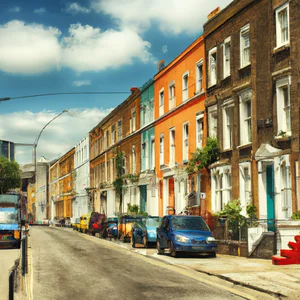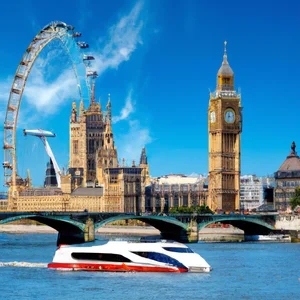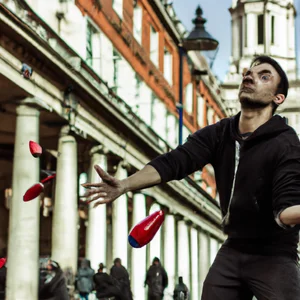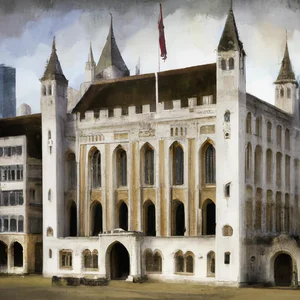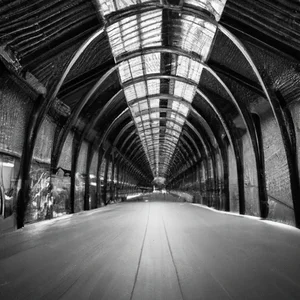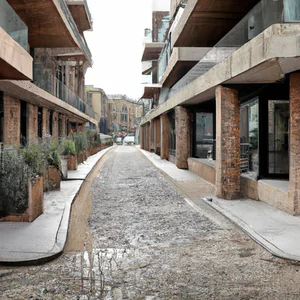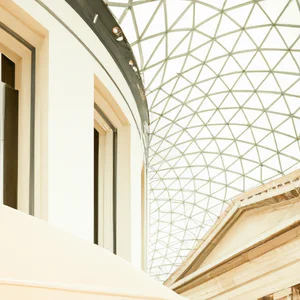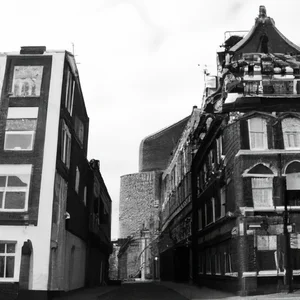Book your experience
The Royal Courts of Justice: Victorian Gothic in the legal heart of London
The Royal Courts of Justice: a piece of Victorian Gothic in the middle of London’s legal district
So, let’s talk about a place that, if you are in London and don’t see it, well, you’re missing out on a piece of history, come on! The Royal Courts of Justice, in short, are a real jewel. Imagine a building that seems to come out of a ghost film, with those spiers and turrets that almost seem to want to touch the sky. It’s a bit as if the judges had decided to build a castle for their work, and I must say that they succeeded very well.
When I first went there, I remember getting lost in the corridors, like a mouse in a maze. There was an atmosphere that enveloped you, almost magical, and the people walking around in there all seemed so serious, with their robes and everything. I don’t know, it made me think of a movie my father likes, where everyone fights for justice.
And then, oh, the gothic! It’s like the stones talk, you know? Those architectures, with their intricate decorations and details that leave you speechless. It’s a bit as if the past embraces you, and you can almost feel the stories that those walls have lived. I think it’s a place that makes you think, because I mean, justice is not just an abstract concept, but something that has to do with the lives of all of us, right?
I don’t know, maybe it’s just my impression, but every time I pass by it, I feel like I’m transported to another era. There is something fascinating about seeing how architecture can tell the story of an entire nation. And, by the way, if you go there, don’t forget to take a look inside too. It’s like opening a book of fairy tales, with rooms that seem to come out of a dream. In short, a real blast from the past!
Discover unique Victorian Gothic architecture
An experience that envelops you
I remember the first time I crossed the threshold of the Royal Courts of Justice: the sun was setting, and golden rays filtered through the intricate stained glass windows, painting the mosaic floor with a kaleidoscope of colour. In that moment, I realized that I was not simply entering a courthouse, but a living work of art, a silent witness to London’s legal history. The magnificence of Victorian Gothic architecture, with its soaring pinnacles and ornate spiers, created an almost mystical atmosphere, a reminder of a time when art and law were inextricably intertwined.
Practical information
The Royal Courts of Justice, designed by architect George Edmund Street and opened in 1882, are a stunning example of Victorian Gothic architecture. Located in the heart of London, these courts are easily accessible by tube. The closest stop is “Temple”, just a few steps away from the majesty of the building. The visit is free, but it is advisable to check the official website for any extraordinary openings or special events.
An insider tip
If you want to take in the architectural beauty without the crowds, try visiting during your lunch break (between 12pm and 2pm) on a weekday. Many lawyers and civil servants go out for break, and you may find the corridors less crowded, allowing you to explore in peace. Also, don’t forget to look up: decorative details, such as sculptures of legal figures and symbols of justice, tell stories of centuries past.
Cultural and historical impact
This extraordinary structure is not only a workplace for lawyers and judges, but is also a symbol of British legal tradition. Victorian Gothic architecture embodies the ideal of justice standing solemn and imposing, reflecting the importance of law in society. The Royal Courts of Justice host cases of great importance, influencing not only the legal system, but also popular culture, as demonstrated by the numerous films and TV series that have taken inspiration from these courtrooms.
Sustainability in legal tourism
While the Royal Courts of Justice are a historic icon, there is a growing commitment to more sustainable practices. During your visit, consider using public transportation to reduce your environmental impact. Furthermore, many local organizations are promoting events that aim to raise public awareness about the importance of social justice and the rule of law in a sustainable way.
An unmissable activity
Don’t just wander the corridors: book a guided tour to discover fascinating anecdotes and details that often escape the distracted eye. During the tour, you will have the opportunity to enter some of the courtrooms, where historic cases that shaped British law were heard.
Myths to dispel
A common misconception is that the Royal Courts of Justice are only accessible to those with legal issues to resolve. In reality, they are open to everyone, and their architectural beauty and historical significance make them an unmissable destination for tourists too. Don’t be fooled by the idea that it’s an exclusive place; here, law and art come together to tell stories that belong to everyone.
A personal reflection
As I walked among the towering columns and intricate details of the Royal Courts of Justice, I wondered: How much do we really know about the stories behind these walls? Every corner of the building seems to tell a story of justice and humanity. Next time you visit London, I invite you to reflect on how architecture can influence our perception of law and justice. What do you think? Could the art and beauty of a place contribute to a deeper sense of justice and responsibility in our society?
Fascinating history of the Royal Courts of Justice
A close encounter with justice
I remember the first time I crossed the threshold of the Royal Courts of Justice: the sunlight filtered through the stained glass windows, projecting a kaleidoscope of colors onto the limestone walls. The atmosphere was filled with incredible reverence, as if every stone told stories of legal battles and justice. As I listened to the whispers of visitors and the rustle of robes, I realized that I was not just witnessing a place of jurisprudence, but a living monument enshrining the history of British law.
Practical information
Located in the heart of London, the Royal Courts of Justice are an extraordinary example of Victorian Gothic architecture, designed by George Edmund Street and inaugurated in 1882. To visit the complex, it is advisable to check the official website [Courts and Tribunals Judiciary](https: //www.judiciary.uk) for up-to-date information on opening times and access. Entrance is free, but it is advisable to book in advance to take part in thematic guided tours which offer an in-depth overview of the history and architecture of the place.
An insider tip
If you want a truly unique experience, try attending a public hearing. Not only will you have the chance to see the British legal system in action, but you will also be immersed in an atmosphere that is difficult to describe. Hearings can range from business law cases to family law matters, offering an odd mix of drama and formality. In most cases, you can enter freely, but make sure you respect the rules of behavior in the classroom.
Cultural and historical impact
The Royal Courts of Justice are not only a symbol of justice, but also an important landmark of British culture. Their architectural style, with turrets and gargoyles that seem to peer into the world below, reflects this a time when law and order was considered fundamental to society. This building has hosted some of the most significant cases in British legal history, helping to shape the legal system we know today.
Sustainable tourism
Interestingly, the Royal Courts of Justice promote responsible tourism practices. During visits, operators encourage visitors to respect the environment and consider the impact of their actions. For example, it is suggested to use public transport to reach the complex, thus contributing to the reduction of air pollution in London.
Immersion in the atmosphere
As you stroll through the corridors of the Royal Courts of Justice, be enveloped by the magnificence of the sculptures and ornate decorations. Every corner tells a story: from the mosaics that adorn the floor, to the strategically placed statues of historical figures. The combination of Gothic architecture and Victorian design creates an environment that is as charming as it is educational.
Activities to try
After visiting the Courts, I recommend you explore the nearby Lincoln’s Inn Fields, the largest public park in London. Here you can relax and reflect on the importance of justice, while admiring the surrounding architecture. You could even organize a picnic, bringing with you a book on British legal history to read in the shade of the ancient trees.
Myths and misconceptions
A common misconception is that the Royal Courts of Justice are only accessible to those with a specific legal interest. In fact, the complex is open to all and offers a unique opportunity to better understand how law and justice works in the United Kingdom. You don’t need to be a lawyer or law student to appreciate the historical and cultural significance of this place.
Final reflection
After exploring the Royal Courts of Justice, I found myself reflecting on how essential justice is to our daily lives. This monument is not just a building; it is a symbol of fundamental values that transcend time and generations. What kind of personal story will you take with you after a visit to this emblematic place?
How to attend a public hearing
A unique experience at the heart of the English legal system
I still remember my first time inside the Royal Courts of Justice. As I walked through the imposing Victorian Gothic doors, my heartbeat seemed to synchronize with the sound of footsteps thronging the corridors. The atmosphere was filled with expectation and a kind of reverence. This was not just a place of justice, but a stage where stories are written that impact people’s lives. Attending a public hearing gives you a rare opportunity to see the law in action and have an experience that goes beyond the law books.
Practical information for participating
Public hearings in the Royal Courts of Justice are generally open to all. Entry is free and no registration is necessary. I advise you to check the official website Justice.gov.uk for hearing times, as they vary depending on the cases scheduled. It’s best to arrive a little early so you have time to explore the beautiful rooms and intricate architectural details that characterize this place.
An insider tip
If you want an authentic experience, try to attend a hearing on a case of public interest or social importance. Not only will you have the opportunity to observe lawyers and witnesses in action, but you may also pick up on nuances of the law that often escape the untrained eye. Also, don’t forget to visit the court library, a true treasure for law enthusiasts, where you can find ancient texts and valuable resources.
The cultural impact of public hearings
Public hearings are not just a legal proceeding; they represent the very essence of democracy and transparency. In a world where legal decisions can have a profound impact on society, attending these hearings gives you a better understanding of how British justice works and its role in shaping social norms.
Sustainability and responsibility in legal tourism
Attending a public hearing is a responsible way to explore London’s legal heritage. It is an experience that not only enriches your knowledge but also supports the local culture. You can contribute to sustainable tourism by avoiding commercial guided tours and giving yourself time to explore historic places independently, respecting the importance of these spaces.
Immerse yourself in the story
The architectural beauty of the Royal Courts of Justice is an irresistible attraction. Gothic details, from stained glass windows to intricate friezes, tell stories of a time gone by. Every corner is a tribute to justice, a physical manifestation of the fight for rights and equity. Don’t forget to bring a camera: the contrasts of light and shadow create stunning scenes.
An activity worth trying
After attending a hearing, I recommend taking a walk around the area. Nearby Lincoln’s Inn Fields is a quiet park where you can reflect on your experience, perhaps reading a law book or simply observing daily life go by around you.
Myths and misconceptions
A common misconception is that attending a public hearing is boring or too technical. On the contrary, hearings can be incredibly engaging, full of emotion and drama that unfolds in real time. It’s not uncommon to witness moments of tension and surprising revelations, just like in a movie!
Final reflection
Have you ever thought about how stories of justice influence our daily lives? Each hearing is a chapter in a larger narrative, about rights, responsibilities and the search for truth. Attending a public hearing is not only a learning opportunity, but an invitation to reflect on how the law shapes our world. Do you feel ready to discover this profound and fascinating dimension of justice?
An alternative guided tour: hidden secrets
A personal experience
When I embarked on my first tour of the Royal Courts of Justice, I didn’t expect to be so fascinated by the Victorian Gothic architecture surrounding this impressive building. As I walked among the intricate sculptures and stained glass windows, an elderly guide, with an enigmatic smile, whispered to me that there is a secret door, an access reserved only for lawyers. My curiosity was sparked: what was behind that door?
Practical information
If you would like to explore the ‘secrets’ of the Royal Courts of Justice, consider taking an alternative guided tour. Several local agencies, such as London Walks, offer unique experiences that go beyond simply explaining legal procedures. These tours include historical anecdotes and curiosities that you wouldn’t find in books. It is advisable to book in advance, especially during the summer months, when the flow of tourists increases.
Insider tip
One of the hidden gems that only an insider could reveal to you is a visit to the Archway, an often overlooked passageway that offers spectacular views of an internal courtyard. Here, you will be able to appreciate the architecture in a more intimate way and discover stories of lawyers who have worked in this prestigious place. Don’t forget to bring your camera: the sunset light that filters through the windows creates an almost magical atmosphere.
Cultural and historical impact
Le Royal Courts of Justice are not only a place of work for lawyers and judges, but also the beating heart of British justice. Their construction, which took place between 1868 and 1882, marks a period in which English law was evolving, reflecting a changing society. This building is not only an architectural masterpiece; it is a symbol of a legal system that has influenced many jurisdictions around the world.
Sustainable tourism
When taking an alternative guided tour, choose operators who promote sustainable tourism. Some tours offer the chance to contribute to local projects, such as the restoration of historic buildings or legal education initiatives for young people. This way, you not only explore the city, but also help preserve its heritage.
Engaging atmosphere
Imagine walking along the corridors of the Royal Courts of Justice, where the echoes of footsteps echo off the walls adorned with intricate sculptures. The air is full of history, and every corner tells a story that deserves to be heard. The scent of ancient wood and the soft lighting of gas lamps envelop you, transporting you to an era where justice was administered with rigor and nobility.
Activities to try
After the tour, I recommend visiting Lincoln’s Inn Fields, a nearby park that offers a great opportunity to reflect on what you just learned. Bring a book or notebook with you and treat yourself to a moment of relaxation immersed in London’s legal history.
Common myths
A common misconception is that the Royal Courts of Justice are only accessible to those with legal business to discuss. In fact, anyone can explore these historic walls. It is a place open to everyone’s curiosity, not just lawyers and judges.
Final reflection
After discovering the secrets of the Royal Courts of Justice, I asked myself: how many stories remain unheard in the folds of our daily lives? Every corner of London has a story to tell, and it’s up to us to decide to listen to it. Are you ready to discover the hidden stories around you?
The cultural importance of English law
A personal experience
I still remember the first time I walked through the doors of the Royal Courts of Justice. The smell of ancient wood and the light that filtered through the stained glass windows created an almost mystical atmosphere. As I walked through the long corridors, a lawyer, visibly passionate about his work, told me how English law had influenced legal systems around the world. That conversation made me realize how deep and rooted the legal culture in England is, not only in the past, but also in the present.
Practical information
English law is one of the oldest and most respected legal systems in the world. England is famous for its common law system, which is based on legal precedent and custom. This approach has influenced numerous countries, from Canada to Australia to the United States. To explore this cultural wealth, you can visit the Royal Courts of Justice, which offer guided tours and public hearings. Be sure to check their official website for updated hours and information.
A little-known tip
If you want a truly unique experience, I recommend attending a hearing of a public law case. These cases often deal with issues of great social relevance and can give you fascinating insight into the legal dynamics at play. Don’t forget to arrive a little early: places are limited and the thrill of seeing justice in action is indescribable!
Cultural and historical impact
English law is not just a legal aspect, but a pillar of British culture. Its evolution has shaped modern society, and many of the laws that regulate our daily lives today are the result of centuries of legal development. The figure of the lawyer, for example, has emerged as a symbol of justice and fairness, a role that continues to exert significant influence in public life.
Sustainable tourism practices
Today, legal tourism in London is becoming more and more aware and responsible. Attending public events or hearings is one way to support an open and inclusive legal practice. Additionally, many organizations are working to make access to justice more equitable, and participating in these initiatives is a great way to contribute to positive change.
Immerse yourself in the atmosphere
Imagine sitting in a historic courtroom, surrounded by Victorian Gothic architecture, as judges argue cases that can change people’s lives. The echoes of the sentences resonate across the ornate walls, creating a sense of respect and reverence that is palpable. This is the beating heart of English law, a place where words have the power to shape society.
An activity worth trying
For an authentic experience, attend a public meeting of the Bar. These events provide the opportunity to hear and interact with experienced lawyers discussing contemporary legal issues. It’s an excellent way to deepen your understanding of English law and to discover how the laws affect everyday life.
Myths to dispel
A common misconception is that English law is inaccessible or complicated. In reality, legal institutions are committed to making the system more understandable and accessible to all. Attending public events and visiting courthouses can help you see that the law is not just for experts, but is a fundamental part of life for all of us.
Final reflection
As you leave the Royal Courts of Justice, ask yourself: what impact does the law have on your daily life? In a world where laws can seem distant and abstract, exploring the cultural importance of English law can offer you a new perspective. Justice is not just a concept, but a reality that affects us all.
Authentic experiences: listen to stories from lawyers
An unexpected encounter
During my visit to the Royal Courts of Justice, I was struck not only by the grandeur of the Victorian Gothic architecture, but also by the vibrant atmosphere that pervaded the corridors. As I wandered through the classrooms, I was lucky enough to come across a lawyer who was preparing for a hearing. With a smile, he invited me to join him for coffee in the courthouse cafeteria. That informal chat turned into a fascinating journey through historical case stories and anecdotes from the legal world, leading me to see the legal system in a new light.
Practical information
The Royal Courts of Justice, located in the heart of London, are open to the public and offer the chance to attend public hearings, but what makes the experience truly memorable is the opportunity to listen to lawyers’ stories. Organizations such as The Law Society and Courts and Tribunals Judiciary offer guided tours and Q&A sessions with industry professionals. I recommend checking their website for times and availability.
An insider tip
A little-known tip is to visit the courthouse cafeteria during breaks in hearings. Here, you will not only enjoy quality coffee, but you will also have the chance to meet lawyers and judges in a more informal setting. The conversations that can be had in this environment can be incredibly enlightening.
The cultural impact of the legal narrative
Listening to lawyers’ stories is not only a fascinating experience; it is also a way to understand the evolution of law and justice in the United Kingdom. Each anecdote reveals details about how the legal system has addressed social issues of historical relevance, from the abolition of slavery to civil rights. These intimate narratives make the legal system more accessible and understandable, transforming our perception of justice.
Responsible tourism
In an age where responsible tourism is increasingly important, hearing stories from lawyers can also serve as a reminder of the importance of law and social justice. Supporting events and activities that promote legal awareness contributes to a more informed and engaged community.
Soak up the atmosphere
Imagine sitting in a crowded coffee shop, surrounded by lawyers discussing cases and legal strategies. The smell of fresh coffee mixes with the echo of sentences pronounced in nearby classrooms. Every story you hear is like a piece of a complex puzzle that makes up the British legal landscape.
An activity worth trying
I recommend you attend a workshop or interactive session organized by the Royal Courts of Justice. These experiences offer a unique opportunity to learn directly from industry professionals, enriching your understanding of the law.
Myths to dispel
A common misconception is that the legal world is distant and inaccessible. In reality, the lawyers’ stories reveal a surprising humanity. Their personal and professional experiences offer a window into the daily challenges and triumphs of the legal system.
Final reflection
After listening to the stories of lawyers, I asked myself: what role does law play in our daily lives? Their narratives not only educate, but invite us to reflect on our place in a society governed by laws and principles. Next time you visit London, take a moment to listen to the stories of those who live the law every day—you might discover a new perspective on the legal world.
Sustainability in legal tourism in London
A personal experience of commitment
I remember my first visit to the Royal Courts of Justice, when, overwhelmed by the majestic Victorian Gothic architecture, I came across a small group of lawyers animatedly discussing how sustainability could impact their daily work. This conversation opened my eyes: legal tourism can be not only a learning experience, but also an opportunity to promote responsible and sustainable practices.
Practical and up-to-date information
Today, several legal bodies and associations in London are actively working to make legal tourism more sustainable. For example, the Law Society promotes events and initiatives aimed at raising public awareness of the importance of sustainability in the legal sector. You can take tours that not only explore the history and architecture of the courts, but also highlight the eco-friendly practices adopted by legal professionals. For more details, visit the Law Society’s official website.
An insider tip
A little-known tip is to attend one of the many events organized by local lawyers’ groups, where sustainability and law are discussed. These events are often held in historic locations, offering a unique opportunity to learn from industry experts in a fascinating setting.
Cultural and historical impact
Sustainability in legal tourism in London is not just a trend: it is a necessary response to a growing awareness of environmental challenges. The Royal Courts of Justice, a symbol of English justice, reflect an era when law and architecture were intertwined. Today, their cultural importance also extends to the need to preserve our environment for future generations.
Sustainable tourism practices
Many tourism operators are adopting sustainable practices, such as using recycled materials for promotion, offering low-impact travel options and partnering with local guides who know and respect the environment. Choosing tours that support these initiatives is a concrete way to contribute to responsible tourism.
Atmosphere and immersion
Imagine walking through the courtyard gardens, surrounded by thriving vegetation, while listening to stories of lawyers who are committed to sustainability. The air is crisp, and the atmosphere is permeated by a sense of collective responsibility, where every step you take contributes to a positive impact.
Activities to try
I recommend you attend a sustainability awareness workshop at one of the courts. These events not only provide a learning opportunity, but also allow you to interact with industry experts and ask questions about how law and sustainability can coexist.
Myths and misconceptions
One of the most common myths is that legal tourism is exclusively for law enthusiasts. In fact, anyone can benefit from it, as legal issues are intertwined with many aspects of daily life and culture. Sustainability is a universal issue that affects us all, and understanding the laws that govern it can inspire positive change.
Final reflection
As I reflect on my experience at the Royal Courts of Justice, I ask myself: how can we all contribute to more sustainable tourism? The next time you visit a historic place, consider the impact of your choices. You may discover that every small gesture counts, and that even a visit can become an act of responsibility.
Decorative details that tell stories
I remember the first time I crossed the threshold of the Royal Courts of Justice, an overwhelming emotion hit me as soon as my eyes fell on the intricate sculptures and architectural details that decorate the building. Every corner seems to tell a story, and every figure carved on the facade is a silent witness to centuries of justice and legality. This is not just a courthouse, but a work of art that encapsulates the essence of Victorian Gothic architecture.
A journey through the details
The Royal Courts of Justice, designed in 1871 by architect George Edmund Street, is a triumph of Victorian Gothic. The decorative details, from the sculptures of saints and historical figures to the ornamental friezes adorning the walls, reflect the craftsmanship of the era. Each architectural element has a function, but also a meaning that goes beyond the simple aesthetic aspect. For example, the figures of justice and truth that tower above the main doors symbolize the core values of the British legal system.
A little-known tip is to pay attention to the small sculpted creatures that decorate the capitals of the columns. Each of them is said to represent an aspect of the law or a virtue necessary for a good lawyer, making the exploration experience even more fascinating and interactive.
The cultural impact
These details aren’t just ornamental; they embody a legal tradition that has influenced not only the United Kingdom, but other nations as well. The richness of symbolism present in the sculptures and decorations invites visitors to reflect on the meaning of justice and law in contemporary society. The Royal Courts of Justice are a cultural heritage site that continues to inspire and influence debate on justice and public architecture.
Sustainability and responsible tourism
In an age where sustainability is at the center of global debate, it is important to note that the Royal Courts of Justice have adopted practices to preserve their heritage. Taking guided tours offers not only the opportunity to learn, but also to contribute to a form of tourism responsible and respectful, which values the history and culture of the place.
An experience not to be missed
If you are visiting London, don’t miss the opportunity to explore the architectural details of the Royal Courts of Justice. A great activity is to join a guided tour, where local experts tell fascinating stories about every sculpture and every corner of the building. This will not only enrich your visit, but will also make you feel part of a centuries-old legal tradition.
Final reflection
As you admire the decorative details of the Royal Courts of Justice, we invite you to reflect on a common myth: that law is a distant and abstract concept. In reality, every sculpture, every sculpted figure reminds us that justice is a fundamental element of our society and that its beauty lies even in the smallest details. As Emerson reminds us, architecture is walking thought; What is the message that these historic structures want to convey to us today?
The secret gardens: oases of tranquility
When I first visited the Royal Courts of Justice, I didn’t expect to come across a corner of tranquility hidden between the majestic Gothic spiers and crowded corridors. After admiring the intricate decorations and grandeur of the interior spaces, I ventured towards the gardens surrounding the building. Here, I discovered an oasis of peace that seemed like a world apart, far from the legal bustle that fills the hearing rooms.
A corner of serenity in the heart of London
These secret gardens are not simply a place to stroll; they are custodians of stories and architectural beauties. Immersed in lush vegetation, with wooden benches and meandering paths, they offer a perfect refuge for those seeking a moment of reflection. Seasonal flowers explode in a riot of color, while ancient trees seem to listen to the whispers of legal stories past. It’s an experience that I found surprisingly refreshing, and I believe every visitor should take the time to explore these spaces.
An insider tip
Few people know that the gardens are open to the public during working hours, but it is best to visit them in the early hours of the morning or late afternoon, when the sun filters through the branches of the trees, creating a magical atmosphere. In these moments, you can enjoy the silence and beauty without the distractions of tourists, giving yourself an authentic and relaxing experience.
The cultural importance of gardens
These gardens are not only a refuge, but also a link to London’s history. Originally designed to provide a place of meditation and reflection for lawyers and judges, they symbolize the importance of finding balance between work and personal life. Their existence reminds all of us that, even in the most serious and institutional places, there are spaces dedicated to tranquility and contemplation.
Sustainable tourism practices
Visiting the gardens of the Royal Courts of Justice is also a step towards more responsible tourism. Here, you can appreciate the beauty of nature, away from the crowded streets of London. Supporting these green spaces helps preserve the urban ecosystem and maintain the city’s beauty for future generations.
An unmissable activity
If you are nearby, grab a coffee from one of the kiosks and treat yourself to a moment of relaxation sitting on a bench, immersed in your thoughts or perhaps reading a good book. It’s an easy way to connect with the atmosphere of the place and reflect on what you’ve seen.
Myths and misconceptions
It is common to think that the Royal Courts of Justice are just a place of work for lawyers and judges, but in reality, they also represent a cultural heritage and a secret garden to explore. Often overlooked by tourists, these gardens are a treasure that deserves to be discovered and appreciated.
Reflecting on my visit, I ask myself: in a world that moves ever faster, how important is it to find moments of tranquility and beauty? The Royal Courts of Justice, with their secret gardens, offer a simple and fascinating answer.
Special events and temporary exhibitions not to be missed
An Unforgettable Personal Experience
During my visit to London, I came across a temporary exhibition at the Royal Courts of Justice celebrating 150 years of history of Victorian Gothic architecture. I will never forget the thrill of walking among the sumptuous tapestries and historical documents, discovering how great trials shaped English society. This experience allowed me to understand not only the architectural beauty of the place, but also its profound cultural significance.
Practical Information
The Royal Courts of Justice, located in the heart of London, regularly host special events and temporary exhibitions that attract both law enthusiasts and the curious. To stay updated on the latest initiatives, it is advisable to visit the official [Royal Courts of Justice] website (https://www.justice.gov.uk/courts/rcj) where details on future events, times and methods of participation are published.
Insider advice
A little-known tip is to take advantage of the evening guided tours which, on some occasions, offer exclusive access to lesser-known parts of the palace. These tours, often limited to a small number of participants, can reveal fascinating stories and hidden corners that are not accessible during the day.
The Cultural and Historical Impact
The Victorian Gothic architecture of the Royal Courts of Justice is not just a visual marvel; it also represents a period of great social and legal change in England. Its construction, which took place between 1868 and 1882, reflects the ambition of a legal system that wished to be more accessible and fair. The temporary exhibitions not only celebrate this history, but also offer an insight into the continuing evolution of British law.
Sustainability in Legal Tourism
Attending events and exhibitions at the Royal Courts of Justice can be a sustainable tourism experience. Many initiatives promote responsible practices, such as using recycled materials for displays and promoting low-carbon events. Choosing to visit in a group or use public transport is one way to contribute to more eco-friendly tourism.
Immerse yourself in the Atmosphere
Imagine entering a frescoed room, with high ceilings and majestic arches, while the sound of heels on the marble floor resonates like an echo of the past. The walls are adorned with works of art that tell stories of justice and truth, creating an atmosphere that can make you feel like you are part of a legal drama from bygone eras.
An Activity to Try
If you are in town during a special event, don’t miss the opportunity to attend a legal writing workshop that is often held in conjunction with the exhibitions. These workshops offer the opportunity to explore creative writing through the prism of law, combining art and justice in a unique experience.
Myths and Misconceptions
A common misconception is that exhibitions at the Royal Courts of Justice are reserved only for jurists or scholars. In fact, they are designed to be accessible to everyone, with guides and information materials designed for anyone who wants to deepen their knowledge of the British legal system.
A Final Reflection
Having explored the architecture and histories of the Royal Courts of Justice, I invite you to reflect: how might the history of law influence our daily lives? Are there lessons to be learned from past challenges that can help us build a better future? Beauty and the complexity of this place are not just a visual appeal, but an opportunity to reconsider our role in society and justice.

 Architecture and Design
Architecture and Design Cities and Regions
Cities and Regions Culture and History
Culture and History Events and Festivals
Events and Festivals Fashion and Shopping
Fashion and Shopping Food and Wine
Food and Wine Nature and Adventure
Nature and Adventure Unique Experiences
Unique Experiences


















